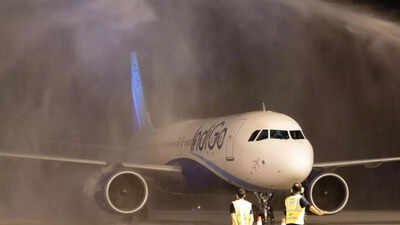- News
- Business News
- India Business News
- Indian aviation sector continues to face disruptions in supply chain: ICRA report
Trending
Indian aviation sector continues to face disruptions in supply chain: ICRA report
India's aviation sector faces a deepening crisis due to supply chain disruptions and engine failures, particularly affecting Pratt & Whitney engines. Airlines are leasing additional aircraft, increasing costs and reducing efficiency. IndiGo and Go Airlines have been significantly impacted, with a substantial number of aircraft grounded, straining capacity despite strong ticket pricing and passenger load factors.
India's aviation sector is grappling with a deepening crisis, as ongoing supply chain disruptions and engine-related challenges continue to ground operations, according to a report by the Investment Information and Credit Rating Agency (ICRA).
The recent report said, “Supply-chain challenges and engine failure issues impact industry capacity; the industry has been facing supply-chain challenges and issues of engine failures for the Pratt and Whitney (P&W) engines supplied to various airlines.”
The situation has been exacerbated by the global recall of Pratt & Whitney (P&W) engines and delays in testing by the manufacturer. As a result, airlines have been compelled to lease additional aircraft—largely through wet lease arrangements—to compensate for the grounded fleet.
This move has driven up lease rentals and operating costs, while also reducing fuel efficiency, particularly because some of the replacement aircraft are older models acquired on spot leases.
The report further talked about the airlines hit worst due to the irregularities in the supply chain. One of those airlines is IndiGo, formally named as InterGlobe Aviation Limited, IndiGo grounded close to 70 aircraft from its fleet due to defects in raw materials required for making engine parts, according to an ANI report.
Another airline was Go airlines which was ordered by the National Company Law Tribunal to be liquidated in January 2025. Go Airlines was among the severely affected due to faulty engines, grounding nearly half of its fleet in FY2024.
In March 2025, around 133 aircraft operated by some Indian airlines were out of service, representing nearly 16 per cent of the total fleet. While this figure is in par from the 154 grounded aircraft reported as of September 30, 2023, it still poses a substantial problem to the industry’s capacity and functioning. These constraints have directly influenced the Available Seat Kilometre (ASKM)—a key metric used to measure airline capacity.
Despite these hurdles, the industry has found some relief through strong ticket pricing (yields), high passenger load factors (PLF), and partial compensation from engine manufacturers, all of which have helped cushion the financial strain to a certain extent.
Compounding the operational difficulties in FY2025 were staff shortages, especially of pilots and cabin crew. These shortages led to frequent flight delays and cancellations, further straining capacity and causing inconvenience to passengers.
Though some recovery is anticipated in FY2026, the Indian aviation sector remains under pressure, contending with multiple challenges that continue to impact its operational efficiency and profitability.

About the Author
TOI Business DeskEnd of Article
Follow Us On Social Media















